扩展功能
文章信息
- 谭昭昭, 王伟明, 李文浩, 卢双舫, 何涛华, 程泽虎
- TAN ZhaoZhao, WANG WeiMing, LI WenHao, LU ShuangFang, HE TaoHua, CHENG ZeHu
- 泌阳凹陷核桃园组三段富有机质泥页岩形成环境及发育模式
- The Sedimentary Environment and Deposition Mode of Organic-Rich Mudstone from the Third Member of Hetaoyuan Formation in the Biyang Depression
- 沉积学报, 2018, 36(6): 1256-1266
- ACTA SEDIMENTOLOGICA SINCA, 2018, 36(6): 1256-1266
- 10.14027/j.issn.1000-0550.2018.096
-
文章历史
- 收稿日期:2017-10-17
- 收修改稿日期: 2018-01-02
2. 中国石油大学(华东)地球科学与技术学院, 山东青岛 266580
2. School of Geosciences, China University of Petroleum(East China), Qingdao, Shandong 266580, China
在全球碳循环中,有机碳主要保存在沉积有机质中[1]。影响有机质富集的因素有很多,主要包括古生产力,有机质保存条件,陆源碎屑输入,沉积速率,古气候及和海(湖)平面升降[2-4]。20世纪80年代以来,关于有机质富集存在两种学派,其中Calvert[5]和Pedersen et al.[6]等认为海相沉积体系中水体的生物产率是控制海相烃源岩发育的最重要的因素,而不是还原环境控制了沉积物中有机质的分布与发育,但是Demaiso et al.[7]和Tyson et al.[8-9]强调烃源岩形成的主控因素是水体的缺氧环境,而与生物产率无关。目前,越来越多的人认为有机质富集受多因素控制,如Stow et al.[10]认为有机质富集的控制因素为有机质供给、地层水缺氧、有机质快速埋藏等;陈践发等[11]认为海相烃源岩的形成受到古气候条件、古生产力、氧化还原环境和沉积速率影响,其中古生产力和氧化还原环境为主控因素;张宝民等[12]认为海洋高生产力是根本,缺氧还原是关键,低沉积速率是基础,前者强调的是生烃母质生物的生存、繁衍环境,后两者强调的是生烃母质的保存条件,三者缺一不可;Li et al.[13-14]认为南海北部海相烃源岩的形成受控于古气候条件、古生产力和氧化还原环境及陆源高等植物输入量,其中前两者为主要控制因素。
由于湖泊水体范围较小,其沉积环境要比海洋的沉积环境变化更为频繁,具体表现为水体盐度,pH值,湖泊生产力以及陆源碎屑物质的输入变化显著[15-16]。Carroll et al.[17]认为坳陷型盆地中有效烃源岩规模和生烃能力受坳陷幅度和湖平面变化的影响,湖盆鼎盛发育期所对应的高位体系域发育期越长,优质烃源岩越发育。Goncalves [16]和Harris et al.[18]认为在湖盆晚坳陷阶段陆源营养物质的输入使得初级生产力得到了提高。对于沉积介质环境,张文正等[19-20]通过岩石学和元素地球化学分析后,认为长7段优质烃源岩发育于淡水—微咸水沉积环境的半深湖—深湖亚相。
泌阳凹陷古近系核桃园组三段发育一套富有机质的湖相泥页岩,是该区主要的生油与储集岩段。前人主要侧重于泥页岩有机质丰度、类型和成熟度,储集空间类型,物性特征以及可采性等方面的研究[21-25],但是对于核桃园组三段沉积时期频繁的湖泊沉积环境变化导致的湖相泥页岩强烈的非均质性认识不足,尤其是对于富有机质泥页岩形成环境及发育模式研究相对薄弱,因此研究该套湖相烃源岩的形成环境,有助于进一步认识泌阳凹陷核桃园组三段富有机质泥页岩的分布和形成机制,为页岩油勘探开发提供参考意见。
1 地质背景泌阳凹陷位于河南省南部,为南襄盆地的一个次级构造单元,是个中新生代的小型断陷盆地,盆地可以划分为四个构造带:南部陡坡构造带、东部断裂构造带、中央深凹陷带和北部缓坡构造带(图 1)。前人研究认为,泌阳凹陷核桃园组泥页岩具备较好的陆相页岩油形成条件[24-25],其湖相泥页岩平面上主要分布在深凹区,纵向上主要发育在古近系核桃园组核二段—核三段[25],该地层沉积时期湖盆经历了频繁的水体盐度变化,核三段上部、核二段下部发育天然碱矿,水体盐度相对较大[26-27]。核桃园组三段可细分为Ⅰ~Ⅷ共8个油组,厚度达1 100~1 700 m,岩性主要为灰色泥岩、白云质泥岩、泥质白云岩、页岩以及粉砂岩[26],其中2、3油组岩性以泥页岩和泥质白云岩为主,局部夹少量粉砂岩,泥页岩段赋存的生物化石种类多、数量丰富,具有较高的有机碳含量,是页岩油有利的生油和聚集层段[22]。本次研究取芯样品来自于泌94井和泌页HF1井核三段,两口井均位于中部凹陷带(图 1),属于半深湖—深湖沉积亚相。由于核三段沉积时期水体沉积环境不断发生变化,湖盆内泥页岩有机质的富集在纵向上存在着较大的非均质性,尤其是总有机碳含量。本文以核桃园组三段2油组和3油组为例,重点探讨了两油组泥页岩层地球化学特征及形成环境,以期揭示湖盆内富有机质泥页岩形成的主控因素及其发育模式,为揭示泥页岩纵向非均质性提供理论依据。
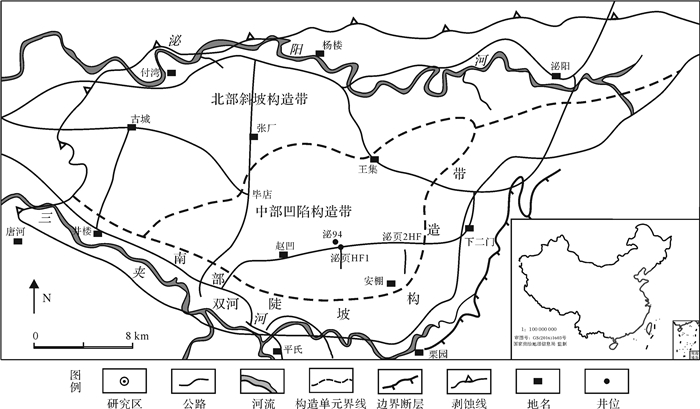
|
| 图 1 南襄盆地泌阳凹陷构造单元 Figure 1 Tectonic units of Biyang sag, Nanxiang Basin |
本次研究的30个泥页岩样品来源于泌94井的核桃园组三段2油组(16个)和泌页HF1井核桃园组三段3油组(14个),两口井均位于中部凹陷带,属于半深湖—深湖沉积亚相。样品设计了四个实验,分别为Rock-Eval(实验样品数30个),GC-MS(实验样品数13个),电感耦合等离子体质谱仪(ICP-MS,实验样品数21个)以及X荧光光谱(XRF,实验样品数21个)分析。Rock-Eval,GC-MS实验由大庆油田研究院完成,ICP-MS和XRF则在南京大学内生金属矿床成矿机制研究国家重点实验室完成,其中XRF仪器采用Thermal 9900型X荧光光谱仪,ICP-MS仪器采用德国耶拿公司的Aurora M90。
3 结果与讨论 3.1 富有机质泥页岩地球化学特征Rock-Eval分析被普遍用于区分有机质类型和评价生烃潜力。核桃园组三段2油组泥页岩氢指数分布在28.81~818.23 mg HC/g TOC,有机质类型从Ⅰ型到Ⅲ型均有分布(图 2);而3油组泥页岩氢指数主要分布在318.12~931.25 mg HC/g TOC,有机质类型以Ⅰ型和Ⅱ1型为主(图 2),其中水生生物贡献占主导。核桃园组三段2油组TOC含量分布在0.22%~3.58%,平均值为1.93%(图 3),但是3油组TOC分布在1.8%~5.09%,平均值为3.37%(图 3)。整体来看,3油组泥页岩有机质更为富集,且有机质类型更好。

|
| 图 2 核桃园组三段2油组和3油组泥页岩IH-Tmax交会图 Figure 2 Variation of hydrogen index as a function of Tmax for shale from beds 2 and 3 in the third member of Hetaoyuan Formation |
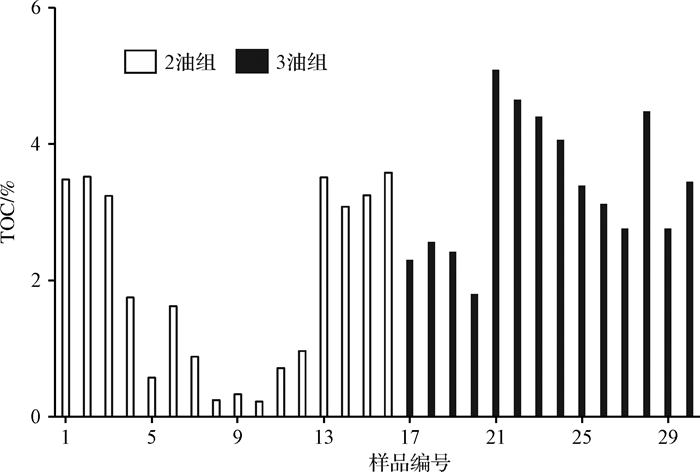
|
| 图 3 核桃园组三段2油组和3油组泥页岩TOC分布图 Figure 3 TOC distribution of shale from beds 2 and 3 in the third member of Hetaoyuan Formation |
古水深分析对于古环境重建和盆地演化研究具有重要意义。近些年来对现代沉积物元素地球化学的研究发现,元素的聚集和分散与水盆深度具有一定的相关性。这一性质主要是元素在沉积过程中所发生的机械分异作用、化学分异作用和生物化学分异作用的结果。例如,金属元素含量比Fe/Mn和(Al+Fe)/(Ca+Mg)被广泛用于古水深研究,它们的比值随着水体的增加而呈现逐渐减小的趋势[28-29]。研究区3油组泥页岩Fe/Mn和(Al+Fe)/(Ca+Mg)平均值分别为23.01和1.30,而2油组泥页岩Fe/Mn和(Al+Fe)/(Ca+Mg)则呈现相对高值,平均值分别为61.09和1.83(表 1),这表明3油组沉积时期,湖盆古水深相对较深,而2油组沉积时期,湖盆古水深相对变浅。
| 编号 | 样号 | 井号 | 深度/m | 岩性 | 层位 | V/(V+Ni) | Ceanom | Sr/Ba | Fe/Mn | (Al+Fe)/(Mg+Ca) | P/% | Al/Ti | Ti/% |
| 1 | H18 | 泌94 | 2 024.4 | 泥岩 | H3Ⅱ | 0.76 | -0.08 | 1.87 | 22.74 | 0.98 | 0.11 | 24.12 | 0.30 |
| 2 | H20 | 泌94 | 2 027.41 | 泥岩 | H3Ⅱ | 0.70 | -0.06 | 1.53 | 32.69 | 1.17 | 0.09 | 25.73 | 0.32 |
| 3 | H21 | 泌94 | 2 028.00 | 泥岩 | H3Ⅱ | 0.71 | -0.07 | 1.79 | 34.66 | 0.92 | 0.09 | 22.83 | 0.33 |
| 4 | H22 | 泌94 | 2 029.31 | 泥岩 | H3Ⅱ | 0.77 | -0.07 | 1.67 | 38.84 | 0.90 | 0.12 | 22.85 | 0.31 |
| 5 | H23 | 泌94 | 2 031.11 | 泥岩 | H3Ⅱ | 0.74 | -0.08 | 1.51 | 174.27 | 5.67 | 0.14 | 22.61 | 0.30 |
| 6 | H25 | 泌94 | 2 109.35 | 泥岩 | H3Ⅱ | 0.79 | -0.06 | 1.17 | 136.84 | 3..39 | 0.08 | 18.15 | 0.55 |
| 7 | H27 | 泌94 | 2 112.00 | 泥岩 | H3Ⅱ | 0.77 | -0.07 | 1.03 | 54.79 | 1.67 | 0.09 | 21.69 | 0.41 |
| 8 | H28 | 泌94 | 2 115.11 | 泥岩 | H3Ⅱ | 0.85 | -0.08 | 1.61 | 37.32 | 0.94 | 0.08 | 22.20 | 0.34 |
| 9 | H29 | 泌94 | 2 116.12 | 泥岩 | H3Ⅱ | 0.75 | -0.07 | 1.08 | 37.27 | 0.93 | 0.15 | 24.37 | 0.30 |
| 10 | H30 | 泌94 | 2 117.85 | 泥岩 | H3Ⅱ | 0.67 | -0.06 | 1.56 | 42.20 | 0.81 | 0.09 | 23.71 | 0.28 |
| 11 | H31 | 泌94 | 2 119.60 | 泥岩 | H3Ⅱ | 0.73 | -0.07 | 0.89 | 60.42 | 2.25 | 0.06 | 23.29 | 0.37 |
| 12 | H80 | 泌页HF1 | 2 431.89 | 页岩 | H3Ⅲ | 0.70 | -0.08 | 0.57 | 16.19 | 0.38 | 0.27 | 21.10 | 0.22 |
| 13 | H82 | 泌页HF1 | 2 433.93 | 页岩 | H3Ⅲ | 0.73 | -0.09 | 0.87 | 4.97 | 0.88 | 0.27 | 26.36 | 0.15 |
| 14 | H83 | 泌页HF1 | 2 435.13 | 页岩 | H3Ⅲ | 0.70 | -0.02 | 1.00 | 5.58 | 0.77 | 0.06 | 27.28 | 0.20 |
| 15 | H85 | 泌页HF1 | 2 436.72 | 页岩 | H3Ⅲ | 0.62 | -0.08 | 0.59 | 19.36 | 2.05 | 0.13 | 26.75 | 0.19 |
| 16 | H86 | 泌页HF1 | 2 438.06 | 页岩 | H3Ⅲ | 0.72 | -0.07 | 0.73 | 42.24 | 1.71 | 0.07 | 25.20 | 0.30 |
| 17 | H87 | 泌页HF1 | 2 440.10 | 页岩 | H3Ⅲ | 0.74 | -0.06 | 0.82 | 53.06 | 2.31 | 0.17 | 25.90 | 0.35 |
| 18 | H88 | 泌页HF1 | 2 443.33 | 页岩 | H3Ⅲ | 0.61 | -0.07 | 0.61 | 19.55 | 2.16 | 0.18 | 26.26 | 0.22 |
| 19 | H90 | 泌页HF1 | 2 444.34 | 页岩 | H3Ⅲ | 0.75 | -0.05 | 1.21 | 7.03 | 0.75 | 0.53 | 24.13 | 0.34 |
| 20 | H92 | 泌页HF1 | 2 447.62 | 页岩 | H3Ⅲ | 0.76 | -0.06 | 0.57 | 8.84 | 0.19 | 0.05 | 30.40 | 0.05 |
| 21 | H93 | 泌页HF1 | 2 450.42 | 页岩 | H3Ⅲ | 0.72 | -0.09 | 0.74 | 53.25 | 1.83 | 0.10 | 24.92 | 0.37 |
| 注:Ceanom=lg[3CeN/(2LaN+NdN)],CeN、LaN和NdN为球粒陨石标准化值。 | |||||||||||||
有机质在还原环境下能够较好地聚集并保存下来[7]。Pr/Ph是判断氧化还原环境的重要参数[30]。2油组和3油组泥页岩都具有较低的Pr/Ph值,分布在0.36~0.86(表 2、图 4a),表明湖盆底部水体均具有较强的还原性。通常V/(V+Ni)的比值也可以用来指示水体氧化强度,其比值大于0.54为缺氧环境,小于0.54为富氧环境[31]。V/(V+Ni)比值表明2油组和3油组水体环境都处于缺氧环境之下(图 5a、表 1)。Ce异常与氧化还原环境有很好的对应关系,Ceanom >-0.1表示Ce富集,反映水体缺氧的还原环境;而Ceanom < -0.1表示Ce亏损,反映水体氧化环境[32-33]。2油组和3油组一共21个样品,其Ceanom均大于-0.1(表 1),表明湖盆底部水体处于还原环境,有利于沉积有机质的保存。
| 编号 | 样号 | 井号 | 深度/m | 岩性 | 层位 | Pr/Ph | Ga/C30H | S/H | 4MSI |
| 1 | H18 | 泌94 | 2 024.40 | 泥岩 | H3Ⅱ | 0.37 | 1.31 | 0.14 | 0.01 |
| 2 | H21 | 泌94 | 2 028.00 | 泥岩 | H3Ⅱ | 0.47 | 0.75 | 0.41 | 0.01 |
| 3 | H23 | 泌94 | 2 031.11 | 泥岩 | H3Ⅱ | 0.47 | 0.52 | 0.44 | 0.02 |
| 4 | H25 | 泌94 | 2 110.00 | 泥岩 | H3Ⅱ | 0.86 | 0.67 | 0.21 | 0.01 |
| 5 | H26 | 泌94 | 2 110.73 | 泥岩 | H3Ⅱ | 0.39 | 1.22 | 0.13 | 0.01 |
| 6 | H28 | 泌94 | 2 115.11 | 泥岩 | H3Ⅱ | 0.36 | 1.13 | 0.29 | 0.01 |
| 7 | H80 | 泌页HF1 | 2 430.55 | 页岩 | H3Ⅲ | 0.36 | 0.33 | 1.96 | 0.18 |
| 8 | H82 | 泌页HF1 | 2 435.10 | 页岩 | H3Ⅲ | 0.46 | 0.23 | 0.20 | 0.28 |
| 9 | H86 | 泌页HF1 | 2 438.90 | 页岩 | H3Ⅲ | 0.45 | 0.22 | 0.39 | 0.28 |
| 10 | H87 | 泌页HF1 | 2 440.00 | 页岩 | H3Ⅲ | 0.45 | 0.25 | 0.17 | 0.19 |
| 11 | H89 | 泌页HF1 | 2 443.30 | 页岩 | H3Ⅲ | 0.44 | 0.31 | 0.19 | 0.15 |
| 12 | H91 | 泌页HF1 | 2 447.60 | 页岩 | H3Ⅲ | 0.37 | 0.29 | 0.63 | 0.09 |
| 13 | H93 | 泌页HF1 | 2 451.10 | 页岩 | H3Ⅲ | 0.38 | 0.71 | 1.51 | 0.06 |
| 注:Ga/C30H=伽马蜡烷/C30藿烷;S/H=甾烷/藿烷;4MSI=4-甲基甾烷/C29甾烷。 | |||||||||
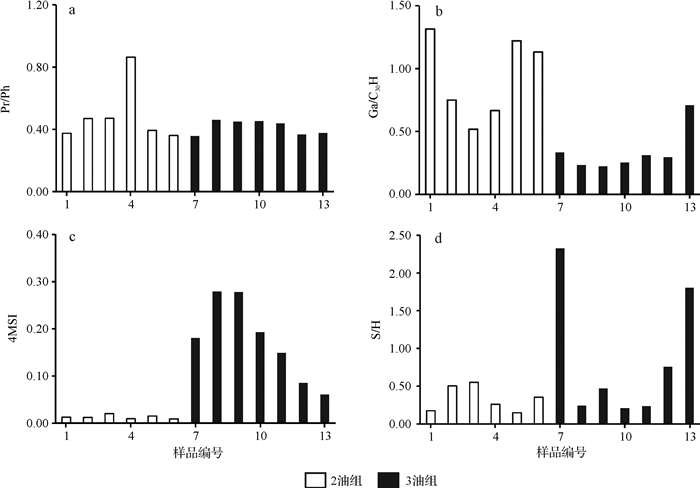
|
| 图 4 核桃园组三段2油组和3油组泥页岩生物标志化合物参数分布图 Figure 4 Biomarker parameters distribution of shale from beds 2 and 3 in the third member of Hetaoyuan Formation |
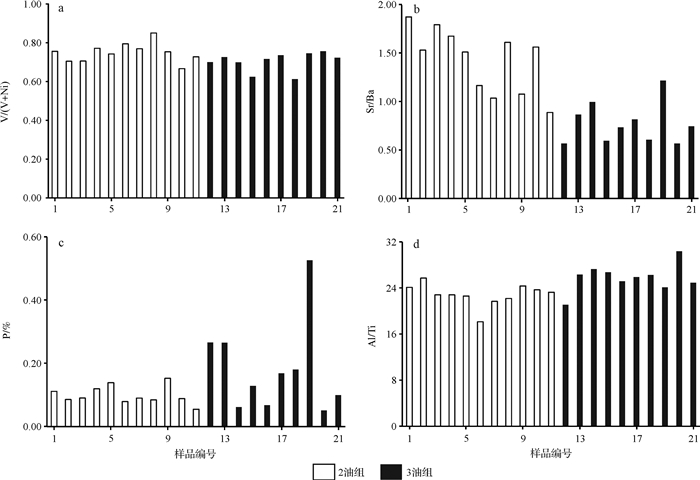
|
| 图 5 核桃园组三段2油组和3油组泥页岩常微量元素参数分布图 Figure 5 Major and trace element parameters distribution of shale from beds 2 and 3 in the third member of Hetaoyuan Formation |
水体盐度是富有机质形成的一个重要因素,高盐度的水体能够使底层水形成一个缺氧环境[34],有利于有机质的保存,但是同时超咸水环境不易于湖泊生物的生存与繁殖。伽马蜡烷普遍被用于揭示有机质的沉积环境,高的伽马蜡烷常常与高盐度和水体分层有关[30, 35-36]。研究区具有相对较高的伽马蜡烷(图 6),伽马蜡烷指数(伽马蜡烷/C30藿烷)分布在0.22~1.31,平均值0.61(表 2),说明核桃园组三段沉积时期水体具有相对较高的盐度。但是对比2油组与3油组,不难发现湖泊水体盐度变化较大,2油组泥岩伽马蜡烷指数分布在0.52~1.31,平均值为0.93,3油组页岩伽马蜡烷指数分布在0.22~0.71,平均值为0.34,明显低于2油组(图 4b),表明2油组沉积时期湖泊水体处于分层较好的超咸水环境,而3油组沉积时期则处于微咸水—半咸水环境。Sr与Ba因其在不同沉积环境中地球化学行为的差异而被广泛应用于古盐度指示[37],Sr/Ba比值越高,盐度越高,反之越低[38]。核桃园组三段2油组泥岩Sr/Ba平均值为1.43明显高于3油组页岩(平均值0.77)(图 5b),进一步证实2油组沉积时期水体属于超咸水环境,而3油组沉积时期水体处于半咸水—微咸水环境。尽管超咸水环境有利于有机质的保存,但是也抑制了藻类等水生生物的生长,随着Sr/Ba值的增加,泥页岩TOC值却逐渐降低(图 7a)。因此2油组沉积时期高盐度的水体环境降低了湖泊生产力。

|
| 图 6 核桃园组三段2油组和3油组泥页岩饱和烃质量色谱图 Figure 6 Mass chromatograms of shale from beds 2 and 3 in the third member of Hetaoyuan Formation |

|
| 图 7 核桃园组三段2油组和3油组泥页岩常微量元素参数与TOC关系图 Figure 7 Relationship of major and trace elements between TOC for shale from beds 2 and 3 in the third member of Hetaoyuan Formation |
汪品先等[39]指出无论湖底是否缺氧,只要湖水表面存在较高的生产力,湖底就能形成优质烃源岩,而藻类勃发是造成高生物生产力的过程之一[40]。甾烷参数能够很好解释海洋和湖泊体系的初级生产力[40-42],4-甲基甾烷主要来源于藻类[43],而甲藻普遍被认为是它们的先质[43-44],核桃园组三段3油组页岩含有高的4-甲基甾烷,而2油组基本不含4-甲基甾烷(图 6),4MSI值(4-甲基甾烷/ΣC29甾烷)差异明显,3油组页岩4MSI值明显高于2油组泥岩(图 4c),表明3油组页岩甲藻对湖泊古生产力的贡献更大。此外,甾烷与藿烷的相对含量可以反映藻类和高等植物以及细菌对有机质的贡献,高的甾烷类/藿烷类化合物比值指示有机质主要来源于浮游生物和底栖藻类等真核生物,低的甾烷类/霍烷类化合物比值与细菌等原核生物有关[45]。3油组页岩S/H(甾烷/藿烷)平均值为0.86,明显高于2油组(平均值为0.33)(图 4d),表明3油组沉积时期湖泊浮游生物更为繁盛,2油组低的S/H值可能与细菌对其有机质贡献有关,因为2油组沉积时期湖泊水体盐度较大,而高盐度湖泊中主要的生物是亲盐型的古细菌和藻类。
湖泊含有丰富的营养元素是其具有较高生产力的前提,湖侵作用带来的大量营养物质有利于水生生物的繁盛。磷含量和Al/Ti比值被广泛用于研究古生产力的指标[14, 46]。核桃园组三段3油组页岩P含量和Al/Ti平均值分别为0.18%和25.83,而2油组泥岩为0.09%和22.87(表 1),相比于2油组,3油组沉积时期高的P元素含量及高的Al/Ti比值(图 5c,d)指示湖泊高度富营养化,导致藻类数量增多及藻类型的变化(图 8)。随着Al/Ti比值的增大,泥页岩TOC逐渐增大(图 7b)。因此核桃园组三段3油组沉积时期高的湖泊生产力是泥页岩有机质富集的主控因素。
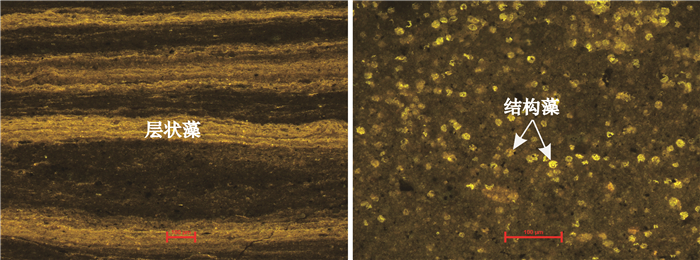
|
| 图 8 H80,2 431.89 m,泌页HF1井3油组页岩反射荧光显微照片 Figure 8 Maceral photographs of shale at 2 431.89 m (H80, Biye HF1 Well) from 3 beds in the third member of Hetaoyuan Formation |
生物标志化合物是指示有机母质生源的良好指标,通常,来源于陆源高等植物的正构烷烃主峰碳在nC25~nC35之间;来源于藻类等水生生物的正构烷烃主峰碳在nC17~nC23之间[47]。同样,规则甾烷C27~C29也可以用来判断有机质母质类型,高含量的规则甾烷C27表明有机质中藻类占优势,而高含量的C29指示高的陆源高等植物输入[48]。2油组主峰碳以高碳数为主,且为后峰型或双峰型,C29占明显优势;而3油组则以低碳数为主,前峰型,C27与C29相对均衡(图 6)。表明2油组沉积时期陆源有机质贡献比3油组大。
3.2.6 陆源碎屑的稀释作用源区陆源碎屑物质的输入对于有机质的富集起到很重要的作用,主要是因为陆源碎屑输入的同时带来了大量的营养物质,使得藻类大量繁殖,但过多的陆源碎屑物质输入会对生产力造成一定的稀释作用[14, 21]。通常,可以利用元素的迁移和沉积分异原理进行陆源碎屑物质输入程度的定性研究。元素钛(Ti)主要集中在黏土矿物中,需通过水流的搬运才能入湖,因而可以用来指示陆源碎屑物质的输入程度[38]。一般而言,Ti元素含量越高,陆源碎屑物质输入越多[3]。核桃园组三段2油组Ti元素含量(0.28%~0.55%,平均值0.35%,表 1)高于3油组(0.19%~0.37%,平均值0.24%),说明2油组沉积时期陆源碎屑物质的输入量相对较高,对湖泊生产力稀释作用更强,从而使有机质富集程度降低。
3.3 富有机质泥页岩发育模式在核桃园组三段3油组沉积时期,湖盆整体处于湖侵体系域,相对低的Fe/Mn和(Al+Fe)/(Ca+Mg)值表明湖泊水体较深,水体处于微咸水—半咸水环境(伽马蜡烷指数分布为0.22~0.71,Sr/Ba < 1),水体分层稳定,Pr/Ph < 1,Ceanom>-0.1,V/(V+Ni)平均值为0.70,均指示湖泊底部水体处于缺氧的还原环境(图 9A),有利于有机质的保存。高的P含量和Al/Ti值说明湖泊具有较高的生产力,生物标志化合物上具有高含量的4-甲基甾烷和高的甾烷/藿烷值,表明湖泊浮游生物极其繁盛(图 9A),该时期湖泊高生产力是有机质富集的主控因素。

|
| 图 9 泌阳凹陷核桃园组三段2油组与3油组富有机质泥页岩发育模式 A. 3油组富有机质页岩发育模式;B. 2油组富有机质泥岩发育模式 Figure 9 Deposition models for rich-organic shale from beds 2 and 3 in the third member of Hetaoyuan Formation |
在核桃园组三段2油组沉积时期,湖盆整体处于湖退体系域,湖泊水体蒸发强烈且沉降速率较低,使得湖盆水体盐度较大(高的伽马蜡烷指数和高的Sr/Ba值),分层明显,限制水体循环,形成缺氧环境(Pr/Ph < 1,Ceanom>-0.1,V/(V+Ni)平均值为0.75),分层水体和缺氧环境有利于有机质的保存,但是高盐度水体环境在一定程度上抑制了藻类的生长,降低了湖泊生物产率(图 9B)。与3油组相比,2油组泥页岩沉积时期相对较低含量P和Al/Ti值表明湖泊具有中等生产力(图 9B)。此外生物标志化合物上具有低的甾烷/藿烷值,湖泊浮游生物不发育。从陆源有机质的贡献来看,核桃园组三段2油组正构烷烃主峰碳以高碳数为主,多为后峰型或双峰型,规则甾烷C29占明显优势,说明其陆源有机质的贡献相对较大。高含量的陆源碎屑物质输入(高含量的Ti,平均值为0.35%)在一定程度上稀释了湖泊生产力,不利于有机质的富集(图 9B)。
4 结论(1) 核桃园组三段2油组泥页岩有机质类型从Ⅰ型到Ⅲ型均有分布,TOC平均值为1.93%;而3油组泥页岩有机质类型以Ⅰ型和Ⅱ1型为主,TOC平均值为3.37%。整体来看,3油组泥页岩有机质更为富集,且有机质类型更好。
(2) 核桃园组三段2、3油组沉积时期水体处于超咸水—微咸水环境,水体分层稳定,但是从3油组到2油组沉积时期,湖泊水体深度逐渐变浅,水体由微咸水向超咸水转化。整体上,湖泊处于缺氧的还原环境,有利于有机质的保存。
(3) 3油组沉积时期湖泊高的生产力是有机质富集的主要控制因素,而2油组沉积时期湖泊具有中等生产力,一定的陆源有机质的输入为该时期富有机质泥页岩的形成提供了条件。
| [1] |
Zonneveld K A F, Versteegh G J M, Kasten S, et al. Selective preservation of organic matter in marine environments; processes and impact on the sedimentary record[J]. Biogeosciences, 2010, 7(2): 483-511. DOI:10.5194/bg-7-483-2010 |
| [2] |
Bechtel A, Jia J L, Strobl S A I, et al. Palaeoenvironmental conditions during deposition of the Upper Cretaceous oil shale sequences in the Songliao Basin (NE China):implications from geochemical analysis[J]. Organic Geochemistry, 2012, 46: 76-95. DOI:10.1016/j.orggeochem.2012.02.003 |
| [3] |
Kennedy M J, Pevear D R, Hill R J, et al. Mineral surface control of organic carbon in black shale[J]. Science, 2002, 295(5555): 657-660. DOI:10.1126/science.1066611 |
| [4] |
Sun P C, Sachsenhofer R F, Liu Z J, et al. Organic matter accumulation in the oil shale-and coal-bearing Huadian Basin (Eocene; NE China)[J]. International Journal of Coal Geology, 2013, 105: 1-15. DOI:10.1016/j.coal.2012.11.009 |
| [5] |
Calvert S E. Oceanographic controls on the accumulation of organic matter in marine sediments[J]. Geological Society, London, Special Publications, 1987, 26(1): 137-151. DOI:10.1144/GSL.SP.1987.026.01.08 |
| [6] |
Pedersen T F, Calvert S E. Anoxia vs. productivity:what controls the formation of organic-carbon-rich sediments and sedimentary rocks?[J]. AAPG Bulletin, 1990, 74(4): 454-466. |
| [7] |
Demaison G J, Moore G T. Anoxic environments and oil source bed genesis[J]. AAPG Bulletin, 1980, 64(8): 1179-1209. |
| [8] |
Tyson R V. The genesis and palynofacies characteristics of marine petroleum source rocks[J]. Geological Society, London, Special Publications, 1987, 26(1): 47-67. DOI:10.1144/GSL.SP.1987.026.01.03 |
| [9] |
Tyson R V, Pearson T H. Modern and ancient continental shelf anoxia:an overview[J]. Geological Society, London, Special Publications, 1991, 58(1): 1-24. DOI:10.1144/GSL.SP.1991.058.01.01 |
| [10] |
Stow D A V, Huc A Y, Bertrand P. Depositional processes of black shales in deep water[J]. Marine and Petroleum Geology, 2001, 18(4): 491-498. DOI:10.1016/S0264-8172(01)00012-5 |
| [11] |
陈践发, 张水昌, 孙省利, 等. 海相碳酸盐岩优质烃源岩发育的主要影响因素[J]. 地质学报, 2006, 80(3): 467-472. [ Chen Jianfa, Zhang Shuichang, Sun Shengli, et al. Main factors influencing marine carbonate source rock formation[J]. Acta Geologica Sinica, 2006, 80(3): 467-472. DOI:10.3321/j.issn:0001-5717.2006.03.021] |
| [12] |
张宝民, 张水昌, 边立曾, 等. 浅析中国新元古-下古生界海相烃源岩发育模式[J]. 科学通报, 2007, 52(增刊1): 58-69. [ Zhang Baomin, Zhang Shuichang, Bian Lizeng, et al. Developmental modes of the Neoproterozoic-Lower Paleozoic marine hydrocarbon source rocks in China[J]. Chinese Science Bulletin, 2007, 52(Suppl.1): 58-69.] |
| [13] |
Li W H, Zhang Z H, Li Y C, et al. The formation environment and development modes of Cenozoic source rocks in the Qiongdongnan Basin[J]. Chinese Journal of Geochemistry, 2012, 31(4): 431-440. DOI:10.1007/s11631-012-0594-y |
| [14] |
Li W H, Zhang Z H, Li Y C, et al. The effect of river-delta system on the formation of the source rocks in the Baiyun sag, Pearl River Mouth Basin[J]. Marine and Petroleum Geology, 2016, 76: 279-289. DOI:10.1016/j.marpetgeo.2016.05.033 |
| [15] |
Garcés B L V, Kelts K, Ito E. Oxygen and carbon isotope trends and sedimentological evolution of a meromictic and saline lacustrine system:the Holocene Medicine Lake basin, North American Great Plains, USA[J]. Palaeogeography, Palaeoclimatology, Palaeoecology, 1995, 117(3/4): 253-278. |
| [16] |
Gonçalves F T T. Organic and isotope geochemistry of the Early Cretaceous rift sequence in the Camamu Basin, Brazil:paleolimnological inferences and source rock models[J]. Organic Geochemistry, 2002, 33(1): 67-80. DOI:10.1016/S0146-6380(01)00128-0 |
| [17] |
Carroll A R, Bohacs K M. Lake-type controls on petroleum source rock potential in nonmarine basins[J]. AAPG Bulletin, 2001, 85(6): 1033-1053. |
| [18] |
Harris N B, Freeman K H, Pancost R D, et al. The character and origin of lacustrine source rocks in the Lower Cretaceous synrift section, Congo Basin, west Africa[J]. AAPG Bulletin, 2004, 88(8): 1163-1184. DOI:10.1306/02260403069 |
| [19] |
张文正, 杨华, 李剑锋, 等. 论鄂尔多斯盆地长7段优质油源岩在低渗透油气成藏富集中的主导作用:强生排烃特征及机理分析[J]. 石油勘探与开发, 2006, 33(3): 289-293. [ Zhang Wenzheng, Yang Hua, Li Jianfeng, et al. Leading effect of high-class source rock of Chang 7 in Ordos Basin on enrichment of low permeability oil-gas accumulation:hydrocarbon generation and expulsion mechanism[J]. Petroleum Exploration and Development, 2006, 33(3): 289-293. DOI:10.3321/j.issn:1000-0747.2006.03.006] |
| [20] |
张文正, 杨华, 杨奕华, 等. 鄂尔多斯盆地延长组长7优质烃源岩的岩石学与元素地球化学特征[J]. 地球化学, 2008, 37(1): 479-485. [ Zhang Wenzheng, Yang Hua, Yang Yihua, et al. Petrology and element geochemistry and development environment of Yanchang Formation Chang-7 high quality source rocks in Ordos Basin[J]. Geochemistry, 2008, 37(1): 479-485.] |
| [21] |
李吉君, 史颖琳, 章新文, 等. 页岩油富集可采主控因素分析:以泌阳凹陷为例[J]. 地球科学-中国地质大学学报, 2014, 39(7): 848-857. [ Li Jijun, Shi Yinglin, Zhang Xinwen, et al. Control factors of enrichment and producibility of shale oil:A case study of Biyang depression[J]. Earth Science-Journal of China University of Geosciences, 2014, 39(7): 848-857.] |
| [22] |
王敏, 陈祥, 严永新, 等. 南襄盆地泌阳凹陷陆相页岩油地质特征与评价[J]. 古地理学报, 2013, 15(5): 663-671. [ Wang Min, Chen Xiang, Yang Yongxin, et al. Geological characteristics and evaluation of continental shale oil in Biyang sag of Nanxiang Basin[J]. Journal of Palaeogeography, 2013, 15(5): 663-671.] |
| [23] |
陈祥, 丁连民, 刘洪涛, 等. 南襄盆地泌阳凹陷陆相页岩储层压裂技术研究与应用[J]. 石油地质与工程, 2011, 25(3): 93-96. [ Chen Xiang, Ding Lianmin, Liu Hongtao, et al. Study and application of fracturing techniques for continental shale reservoir in Biyang depression of Nanxiang Basin[J]. Petroleum Geology and Engineering, 2011, 25(3): 93-96. DOI:10.3969/j.issn.1673-8217.2011.03.029] |
| [24] |
陈祥, 王敏, 严永新, 等. 泌阳凹陷陆相页岩油气成藏条件[J]. 石油与天然气地质, 2011, 32(4): 568-576. [ Chen Xiang, Wang Min, Yan Yongxin, et al. Accumulation conditions for continental shale oil and gas in the Biyang depression[J]. Oil & Gas Geology, 2011, 32(4): 568-576.] |
| [25] |
章新文, 王优先, 王根林, 等. 河南省南襄盆地泌阳凹陷古近系核桃园组湖相页岩油储集层特征[J]. 古地理学报, 2015, 17(1): 107-118. [ Zhang Xinwen, Wang Youxian, Wang Genlin, et al. Reservoir characteristics of lacustrine shale oil of the Paleogene Hetaoyuan Formation in Biyang sag of Nanxiang Basin, Henan Province[J]. Journal of Palaeogeography, 2015, 17(1): 107-118.] |
| [26] |
易承龙. 河南省泌阳凹陷安棚地区古近系核桃园组含碱地层层序特征及其意义[J]. 古地理学报, 2016, 18(1): 93-100. [ Yi Chenglong. Sequence stratigraphy characteristics and its significance of alkaliferous strata of the Paleogene Hetaoyuan Formation in Anpeng area, Biyang sag in Henan province[J]. Journal of Palaeogeography, 2016, 18(1): 93-100.] |
| [27] |
马素萍, 夏燕青, 田春桃, 等. 南襄盆地泌阳凹陷湖相碳酸盐岩烃源岩沉积环境的元素地球化学标志[J]. 矿物岩石地球化学通报, 2013, 32(4): 456-462. [ Ma Suping, Xia Yanqing, Tian Chuntao, et al. Elemental geochemical indicators for sedimentary environment in lacustrine carbonate source rocks of the Biyang depression, Nanxiang Basin[J]. Bulletin of Mineralogy, Petrology and Geochemistry, 2013, 32(4): 456-462. DOI:10.3969/j.issn.1007-2802.2013.04.009] |
| [28] |
王春连, 刘成林, 胡海兵, 等. 江汉盆地江陵凹陷南缘古新统沙市组四段含盐岩系沉积特征及其沉积环境意义[J]. 古地理学报, 2012, 14(2): 165-175. [ Wang Chunlian, Liu Chenglin, Hu Haibing, et al. Sedimentary characteristics and its environmental significance of salt-bearing strata of the Member 4 of Paleocene Shashi Formation in southern margin of Jiangling depression, Jianghan Basin[J]. Journal of Palaeogeography, 2012, 14(2): 165-175.] |
| [29] |
李浩, 陆建林, 李瑞磊, 等. 长岭断陷下白垩统湖相烃源岩形成古环境及主控因素[J]. 地球科学, 2017, 42(10): 1774-1786. [ Li Hao, Lu Jianlin, Li Ruilei, et al. Generation paleoenvironment and its controlling factors of lower cretaceous lacustrine hydrocarbon source rocks in Changling depression, south Songliao Basin[J]. Earth Science, 2017, 42(10): 1774-1786.] |
| [30] |
Peters K E, Walters C C, Moldowan J M. The biomarker guide, Volume 2:biomarkers and isotopes in petroleum exploration and earth history[M]. Cambridge: Cambridge University Press, 2005: 1155.
|
| [31] |
Hatch J R, Leventhal J S. Relationship between inferred redox potential of the depositional environment and geochemistry of the Upper Pennsylvanian (Missourian) Stark Shale Member of the Dennis Limestone, Wabaunsee County, Kansas, U.S.A[J]. Chemical Geology, 1992, 99(1/2/3): 65-82. |
| [32] |
Shields G, Stille P. Diagenetic constraints on the use of cerium anomalies as palaeoseawater redox proxies:an isotopic and REE study of Cambrian phosphorites[J]. Chemical Geology, 2001, 175(1/2): 29-48. |
| [33] |
Wyndham T, McCulloch M, Fallon S, et al. High-resolution coral records of rare earth elements in coastal seawater:biogeochemical cycling and a new environmental proxy[J]. Geochimica et Cosmochimica Acta, 2004, 68(9): 2067-2080. DOI:10.1016/j.gca.2003.11.004 |
| [34] |
Katz B J. Factors controlling the development of lacustrine petroleum source rocks-an update[M]//Huc A Y. Paleogeography, paleoclimate, and source rocks. Houston, Texas, USA: American Association of Petroleum Geologists, 1995: 61-79.
|
| [35] |
张枝焕, 杨藩, 李东明, 等. 中国新生界咸化湖相有机地球化学研究进展[J]. 地球科学进展, 2000, 15(1): 65-70. [ Zhang Zhihuan, Yang Fan, Li Dongming, et al. The organic geochemistry research progress in Cenozoic Salified lake in China[J]. Advance in Earth Science, 2000, 15(1): 65-70. DOI:10.3321/j.issn:1001-8166.2000.01.010] |
| [36] |
冯子辉, 霍秋立, 王雪, 等. 松辽盆地松科1井晚白垩世沉积地层有机地球化学研究[J]. 地学前缘, 2009, 16(5): 181-191. [ Feng Zihui, Huo Qiuli, Wang Xue, et al. Geochemical research on the Late Cretaceous strata of Well SK1 in Songliao Basin[J]. Earth Science Frontiers, 2009, 16(5): 181-191. DOI:10.3321/j.issn:1005-2321.2009.05.018] |
| [37] |
刘宝珺. 沉积岩石学[M]. 北京: 地质出版社, 1980. [ Liu Baojun. Sedimentary petrology[M]. Beijing: Geological Publishing House, 1980.]
|
| [38] |
邓宏文, 钱凯. 沉积地球化学与环境分析[M]. 兰州: 甘肃科学技术出版社, 1993: 1-154. [ Deng Hongwen, Qian Kai. Sedimentary geochemistry and environmental analysis[M]. Lanzhou: Gansu Science and Technology Press, 1993: 1-154.]
|
| [39] |
汪品先, 刘传联. 含油盆地古湖泊学研究方法[M]. 北京: 海洋出版社, 1993. [ Wang Pinxian, Liu Chuanlian. Oil-bearing basin ancient lakes science research methods[M]. Beijing: China Ocean Press, 1993.]
|
| [40] |
刘传联, 徐金鲤, 汪品先. 藻类勃发:湖相油源岩形成的一种重要机制[J]. 地质论评, 2001, 47(2): 207-210. [ Liu Chuanlian, Xu Jinli, Wang Pinxian. Algal blooms:the primary mechanism in the formation of lacustrine petroleum source rocks[J]. Geological Review, 2001, 47(2): 207-210. DOI:10.3321/j.issn:0371-5736.2001.02.015] |
| [41] |
Volkman J K, Barrett S M, Blackburn S I, et al. Microalgal biomarkers:a review of recent research developments[J]. Organic Geochemistry, 1998, 29(5/6/7): 1163-1179. |
| [42] |
Sepúlveda J, Wendler J, Leider A, et al. Molecular isotopic evidence of environmental and ecological changes across the Cenomanian-Turonian boundary in the Levant Platform of central Jordan[J]. Organic Geochemistry, 2009, 40(5): 553-568. DOI:10.1016/j.orggeochem.2009.02.009 |
| [43] |
de Leeuw J W, Rijpstra W I C, Schenck P A, et al. Free, esterified and residual bound sterols in Black Sea Unit I sediments[J]. Geochimica et Cosmochimica Acta, 1983, 47(3): 455-465. DOI:10.1016/0016-7037(83)90268-5 |
| [44] |
Summons R E, Volkman J K, Boreham C J. Dinosterane and other steroidal hydrocarbons of dinoflagellate origin in sediments and petroleum[J]. Geochimica et Cosmochimica Acta, 1987, 51(11): 3075-3082. DOI:10.1016/0016-7037(87)90381-4 |
| [45] |
Peters K E, Moldowan J M. The biomarker guide:Interpreting molecular fossils in petroleum and ancient sediments[M]. New Jersey: Prentice-Hall, 1993: 363.
|
| [46] |
Schoepfer S D, Shen Jun, Wei Hengye, et al. Total organic carbon, organic phosphorus, and biogenic barium fluxes as proxies for paleomarine productivity[J]. Earth-Science Reviews, 2015, 149: 23-52. DOI:10.1016/j.earscirev.2014.08.017 |
| [47] |
Volkman J K, Kearney P, Jeffrey S W. A new source of 4-methyl sterols and 5α(H)-stanols in sediments:prymnesiophyte microalgae of the genus Pavlova[J]. Organic Geochemistry, 1990, 15(5): 489-497. DOI:10.1016/0146-6380(90)90094-G |
| [48] |
Bechtel A, Reischenbacher D, Sachsenhofer R F, et al. Paleogeography and paleoecology of the upper Miocene Zillingdorf lignite deposit (Austria)[J]. International Journal of Coal Geology, 2007, 69(3): 119-143. DOI:10.1016/j.coal.2006.03.001 |
 2018, Vol. 36
2018, Vol. 36

